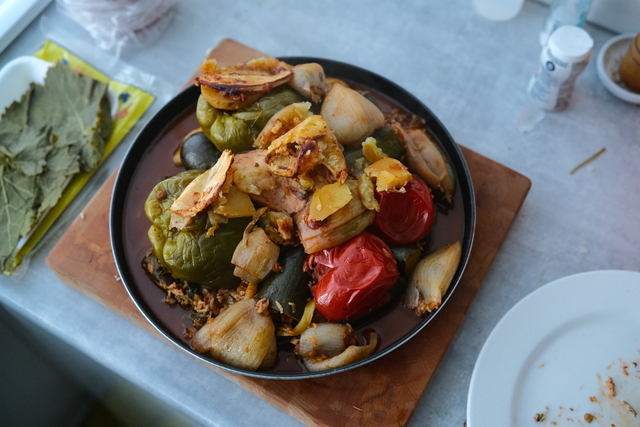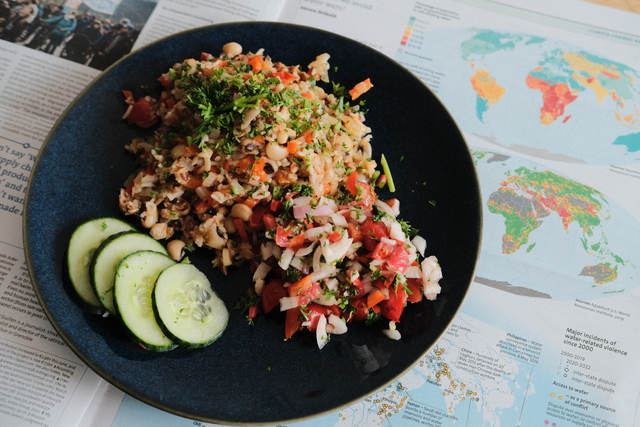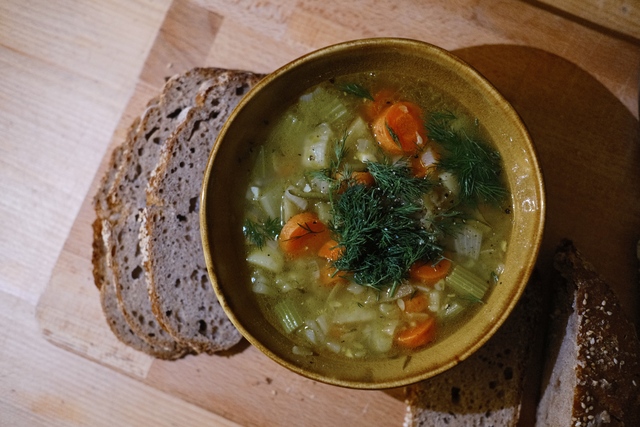Cooking
To appreciate the immense diversity of our world, I'm trying to cook dishes from all countries in the world. I will keep track of the countries, cultures, and cuisines I have been researching and cooking from in evergreen notes.
Running total 37/197
Three most recent dishes
I organize my notes on different cuisines by splitting them into rough geographical areas with the intention of grouping together similar cuisines. A country's cuisine has rarely developed on its own. Cuisines are as dynamic, flexible, and arbitrary as the concept of nation states and their borders. I wrote some more detailed thoughts on this in the past.
Let's start from ten top-level regions.
- Africa 6/55
- Central Asia 1/5
- East Asia 3/6
- Europe 8/44
- Middle East 7/19
- North America 7/23
- Pacific 0/14
- South America 3/12
- South Asia 1/8
- Southeast Asia 1/11
Africa
African cuisines are further categorized by cardinal directions.
Northern Africa 2/6
Influences from Phoenicians (sausages), Carthaginians (wheat, semolina), Berbers (couscous), Arabs (spices: saffron, nutmeg, cinnamon, ginger, cloves), Ottoman Turks (pastries), and New World (potatoes, tomatoes, zucchini, chili peppers).
- Egypt
- Koshari rice, macaroni, lentils, spiced tomato sauce, chickpeas
- Tunisia
- Lablabi chickpeas in garlic-cumin broth
Eastern Africa 2/19
Southern Africa 0/5
Western Africa 2/16
Many of the dishes I list under specific countries are mostly eaten throughout the whole region. There might be small debates over where dishes originate from, but ultimately it remains hard to tell, as most of these countries are rather arbitrary and actually consist of hundreds of different tribes.
- Ghana
- Red red and kelewele black eyed peas in palm oil with spiced fried plantain
- Fufu pounded dough from boiled cassave and plantains
- Nigeria
- Jollof and obe ata rice and spicy red pepper sauce
- Ewa riso stewed beans
Central Africa 0/9
Influenced by Swahilis and Portuguese (see Wikipedia).
Central Asia
- Kazakhstan
- Beshbarmak chopped boiled meat with noodles and onion sauce
- Tajikistan
- Qurutob (TODO)
East Asia
China, Japan, {North, South}-Korea, Mongolia, Taiwan
See Wikipedia for a very detailed list of cuisines in this region.
- China
- Mapo tofu soft tofu in a spicy, Sichuan broth
- Cumin lamb noodles
- Sichuan Yu Xiang eggplant
- Japan
- Miso soup
- Furikake seasoning from kombu and katsuobushi
- Gyoza pan-fried dumplings
- South-Korea
- Tteokbokki simmered rice cakes
- Yachaejeon vegetable pancakes
Europe
Northern Europe 1/10
- Sweden
- Kanelbulle cinnamon rolls
Eastern Europe 1/10
- Poland
- Zupa ogórkowa sour cucumber soup
Southern Europe 2/15
- Italy
- Ribollita Tuscan bread soup
- Bagna càuda Piedmont garlic & anchovies fondue
- Risotto with mushrooms
- Fresh pasta
- Focaccia
- Pesto
- Spain
- Gazpacho cold tomato soup
Western Europe 4/9
- Belgium
- Moules-frites blue mussels and fries
- France
- Onion soup
- Netherlands
- Hutspot mashed potatoes, carrots, onions
- Switzerland
- Cheese fondue
Middle East
There is so much to write here.
Let me include Arab countries in Western Asia in the catch-all term Middle East for the sake of simplicity, though geographically inaccurate.
Some notes on historical cuisines in the Middle East, from Cuisine and Culture by Linda Civitello.
The earliest Muslim recipes come from Baghdad (1226) recorded by al-Baghdadi. There are many tagines; stews of meat and fruits simmered for hours. For example, mishmishiya is made with lamb and dried apricots. Spices included cumin, coriander, cinnamon, ginger, and black pepper. Saffron provided color. Ground almonds provided thickening. Stews were perfumed with water distilled from rose petals or orange blossoms.
Milk (sheep or goat) was made into yogurt or preserved in salty cheese like feta and kasseri. Vegetables and pulses (e.g., aubergine and chickpeas) were puréed and mixed with garlic, lemon, salt, and sesame paste to make baba ghanoush and hummus. Spinach was eaten often. There were breads slapped onto the side of an oven called a tannur (like the Indian tandoor). Rice was imported from Asia and mixed with dried fruit and nuts to make pilaf. And they ate couscous—which today is the national dish in Northern African countries like Morocco, Tunisia, and Algeria. Grape leaves and aubergines were stuffed.
- Iran
- Persian saffron rice with tahdig
- Baghali ghatogh stew from fava beans, dill, and eggs
- Khoresh karafs celery stew
- Kuku sabzi herb frittata
- Mast-o khiar strained yogurt with cucumber
- Kashk-e bademjan aubergine and dairy dip
- Iraq
- Dolma stuffed vegetables
- Israel
- Sabich pita stuffed with fried aubergine
- Lebanon
- Foul mdamas fava beans
- Msabaha mashed chickpeas with tahini-lemon dressing
- Labneh za'atar strained yogurt with spice mix
- Palestine
- Ful mudammas stew of fava beans
- Rummaniyya lentil-aubergine-pomegranate stew
- Saudi Arabia
- Chicken kabsa mixed rice dish with spices
- Turkey
- Menemen eggs, tomato, green pepper
- Lahmacun Turkish pizza
- Baklava
North America
- United States
- Pancakes
- Gumbo
Central America 3/7
- Costa Rica
- Gallo pinto rice and beans
- El Salvador
- Casamiento rice and beans
- Mexico
- Black bean tacos with pico de gallo
Carribean 3/14
- Cuba
- Moros y Cristianos rice and beans
- Suriname
- Roti aloopuri with sweet tempeh
- Trinidad and Tobago
- Sada roti with three vegan curries
Pacific
South America
- Argentina
- Asado barbecue; various dishes
- Brazil
- Feijoada bean and pork stew with rice
- Colombia
- Ajiaco meats and potato soup (but then vegan)
South Asia
- India
- Safaid channe chickpeas in ginger sauce
- Palak raita spinach and yogurt salad
- Malai aam mangoes in thickened milk sauce
- Chapati unleavened flatbread baked on a griddle
- Khichdi rice and lentils
- Spinach dal
- Punjabi lobia black-eyed bean curry
Southeast Asia
- Indonesia
- Tempeh orek
- Philippines
- Tortang talong (TODO)


